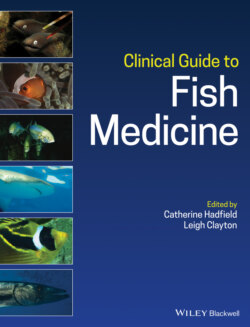Читать книгу Clinical Guide to Fish Medicine - Группа авторов - Страница 36
Anatomy of Cartilaginous Fish
ОглавлениеThis section highlights the differences between cartilaginous fish and bony fish (Box A1.1).
Table A1.4 Ovarian types in fish.
Source: Stoskopf (1993). © 1993, Elsevier.
| Definition | Examples | |
|---|---|---|
| Cystovarian | Ova released into oviduct | Most bony fish |
| Gymnovarian | Ova released into coelom, then ostium, then oviduct | Lungfish (Dipnoi), sturgeon (Acipenseridae), bowfin (Amia calva), cartilaginous fish |
| Semicystovarian (secondary gymnovarian) | Ova released into coelom, then through urogenital pore | Salmonids (Salmonidae) |
Table A1.5 Example of reproductive modalities in bony fish.
Source: Lodé (2012). © John Wiley & Sons.
| Definition | Examples | |
|---|---|---|
| Ovuliparity | Ova expelled externally, then fertilized | Salmonids (Salmonidae), sticklebacks (Gasterosteidae) |
| Oviparous | Internal fertilization, then ova expelled externally | Most teleost species |
| Ovoviviparous | Internal fertilization, retention of ova in body for embryo development, live births | Some rockfish (Sebastidae) |
| Viviparous (histotrophic or lecithotrophic) | Embryo development in body, nutrients provided by body: glandular, oophagy, adelphophagy | Guppies, mollies (Poecilidae) |
| Viviparous (hemotrophic or matrotrophic) | Embryo development in body, nutrients provided by body: pseudoplacentation or placentation | Four‐eyed fish (Anablepidae), cusk‐eels (Ophidiidae), some blennies (Clinidae), some rockfish (Sebastidae), splitfins (Goodeidae), halfbeaks (Hemiramphidae) |
